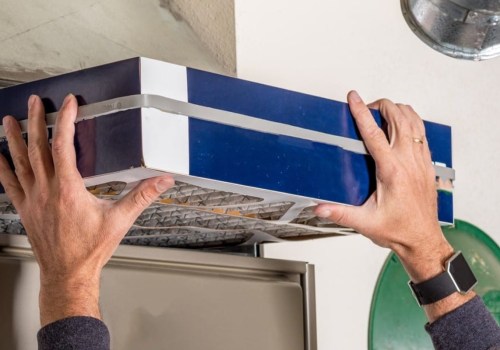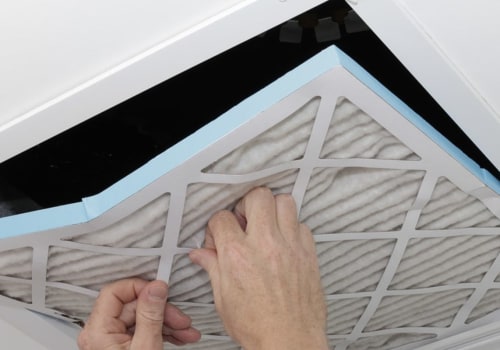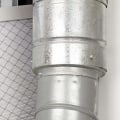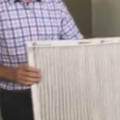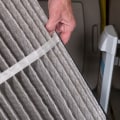Air Duct Sealing Service in Stuart FL
Air duct sealing is an essential maintenance practice that ensures optimal performance and efficiency of HVAC systems. This explores the benefits, signs, and importance of professional air duct sealing service in Stuart, FL. It also compares DIY methods with professional services and provides insights into maintaining sealed air ducts. By adhering to these guidelines, readers will gain a comprehensive understanding of the significance of air duct sealing and how to find the right service provider for their needs.
Benefits of Air Duct Sealing
The benefits of air duct sealing include improved energy efficiency, enhanced indoor air quality, and reduced HVAC system maintenance. Air ducts are an essential component of any heating, ventilation, and air conditioning (HVAC) system. These ducts can accumulate dust, dirt, and other contaminants that can negatively impact the overall performance of the system. Regular air duct cleaning is necessary to remove such buildup and maintain optimal airflow.
One significant benefit of air duct sealing is improved energy efficiency. When there are leaks or gaps in the ductwork, conditioned air can escape into unconditioned spaces such as attics or crawl spaces. This results in wasted energy and increased utility bills. By properly sealing the air ducts, homeowners can prevent this unnecessary loss of heated or cooled air.
Air duct sealing contributes to enhanced indoor air quality. The accumulation of dust and debris within the ductwork can circulate throughout living spaces when the HVAC system is running. This can lead to respiratory issues for individuals with allergies or asthma. By cleaning and sealing the air ducts regularly, homeowners can minimize airborne pollutants and improve overall indoor air quality.
Lastly, proper maintenance through regular cleaning and sealing helps reduce HVAC system maintenance requirements. A clean and sealed system experiences less strain on its components due to improved airflow dynamics. As a result, there will be fewer breakdowns and repair costs associated with the HVAC system.
Signs You Need Air Duct Sealing
This focuses on the signs that indicate the need for air duct sealing, including high energy bills, uneven heating or cooling, and excessive dust or allergies. High energy bills can be an indication of leaks in the air ducts, leading to inefficient heating or cooling systems. Uneven heating or cooling in different areas of a building can also suggest issues with air ducts that require sealing. Excessive dust or allergies may result from unsealed air ducts allowing contaminants to enter the living spaces. Identifying these signs is crucial for improving energy efficiency and maintaining indoor air quality.
High Energy Bills
One possible sentence could be: "High energy bills can often be attributed to inefficiencies in the air duct system." Lowering expenses and improving energy efficiency are important goals for homeowners. Inefficient air duct systems can lead to significant energy losses, resulting in higher utility bills. Unsealed or poorly sealed air ducts allow conditioned air to escape, forcing HVAC systems to work harder and consume more energy to maintain desired indoor temperatures. Leaky ductwork can introduce unconditioned air from attics, crawl spaces, or garages into living spaces, further increasing energy consumption. By addressing these issues through professional air duct sealing services, homeowners can significantly reduce their energy costs and improve overall energy efficiency. Properly sealed air ducts ensure that conditioned air is delivered efficiently throughout the home without any leaks or wastage, leading to lower expenses and increased comfort.
Uneven Heating or Cooling
Uneven heating or cooling can be a common issue in residential buildings due to factors such as poor insulation, improper HVAC system design, or blocked air vents. Troubleshooting tips for this problem involve several steps. First, check the thermostat settings to ensure they are set correctly. Next, inspect and clean the air filters regularly as clogged filters can restrict airflow and lead to temperature imbalances. It is essential to check for any obstructions in the air vents and remove them if present. Finally, consider scheduling regular maintenance of the HVAC system with a professional technician who can assess the overall efficiency and performance of the system. By following these troubleshooting tips and implementing proper maintenance practices, homeowners can address uneven heating or cooling issues effectively in their residential buildings.
Excessive Dust or Allergies
Excessive dust or allergies can be a significant concern in residential buildings, often caused by factors such as poor air quality, lack of proper ventilation, or inadequate cleaning practices. Excessive accumulation of dust particles can trigger allergic reactions in individuals with sensitivities. These allergens can include pollen, pet dander, mold spores, and dust mites. Allergies resulting from these irritants can cause symptoms such as sneezing, coughing, itching, and watery eyes. Additionally, excessive dust can also lead to respiratory issues and exacerbate existing respiratory conditions like asthma. To mitigate these problems, it is crucial to improve indoor air quality through regular cleaning routines that target dust removal. This includes vacuuming carpets and upholstery frequently, using high-efficiency air filters in HVAC systems, and implementing proper ventilation strategies to promote airflow and minimize the buildup of contaminants.
Importance of Professional Air Duct Sealing
The significance of employing a professional service for air duct sealing lies in their expertise and ability to ensure proper sealing, minimizing energy loss and enhancing indoor air quality. Professional air duct sealing offers several benefits that make it worth considering despite the cost. Firstly, proper sealing helps to minimize energy loss by preventing conditioned air from escaping through leaks or gaps in the ductwork. This can result in significant energy savings over time, as the HVAC system doesn't have to work as hard to maintain desired indoor temperatures. Professional air duct sealing can improve indoor air quality by reducing the infiltration of dust, allergens, and other pollutants into the living space. By effectively sealing off potential entry points for contaminants, occupants can enjoy cleaner and healthier air inside their homes or buildings.
While there is a cost associated with hiring professionals for air duct sealing services in Stuart, FL, it is important to consider the long-term benefits that come with it. The initial investment can be offset by energy savings resulting from reduced HVAC usage. Improved indoor air quality can lead to fewer health issues and lower medical expenses related to respiratory problems caused by poor air quality. Overall, professional air duct sealing provides a worthwhile return on investment by improving energy efficiency and promoting better indoor health for occupants.
The Air Duct Sealing Process
This will focus on the air duct sealing process, specifically addressing three key points:
Identification of leaks and gaps: The first step in this process involves identifying any leaks or gaps in the air duct system, which may contribute to energy loss and decreased efficiency.
Cleaning and preparation: Once identified, thorough cleaning and preparation are necessary to ensure proper adhesion of the sealant.
Application of sealant: The sealant is applied to effectively seal any remaining gaps or leaks to improve the overall performance and energy efficiency of the air duct system.
Identification of Leaks and Gaps
To identify leaks and gaps in air ducts, a comprehensive inspection is conducted using specialized tools and techniques. Air duct leaks can occur due to various factors such as poor installation, aging of the ductwork, or damage caused by pests or rodents. These leaks can result in significant energy loss and reduced efficiency of heating and cooling systems. The inspection process involves examining the entire air duct system for any visible signs of leakage, such as disconnected joints or damaged insulation. In addition to visual inspection, specialized tools like smoke pencils or thermal imaging cameras may be used to detect hidden leaks that are not easily visible to the naked eye. Air duct insulation is also assessed during the inspection process to ensure its effectiveness in preventing heat transfer and minimizing energy losses. Overall, this meticulous identification of leaks and gaps plays a crucial role in determining the extent of repair or sealing required for optimal functioning of air duct systems.
Cleaning and Preparation
Cleaning and preparation of the air duct system involves removing dust, debris, and other contaminants to ensure optimal performance and improved indoor air quality. To achieve this, various cleaning techniques are employed. The most common technique is mechanical agitation, which uses brushes or rotating devices to dislodge dirt and debris from the duct surfaces. Another method is compressed air cleaning, where high-pressure air is blown into the ducts to remove loose particles. Chemical agents may also be used for disinfection purposes. Specific equipment is necessary for these cleaning processes, such as vacuum systems with high-efficiency particulate air (HEPA) filters to capture and contain the dislodged contaminants. Specialized tools like rotary brushes and pneumatic whips aid in reaching deep into the ductwork for thorough cleaning. Proper cleaning techniques and appropriate equipment are essential in ensuring a clean and well-prepared air duct system that promotes better indoor air quality.
Application of Sealant
After the thorough cleaning and preparation of air ducts, the next crucial step in the process is the application of sealant. This step ensures that any existing leaks or gaps are effectively sealed to prevent air leakage and improve energy efficiency. Proper application techniques are essential to achieve optimal results. First, it is important to select a high-quality sealant specifically designed for air ducts. The sealant should be applied evenly and generously using either a brush or an airless sprayer, ensuring complete coverage of all seams and joints. Common mistakes during this step include insufficient application of sealant, leading to ineffective sealing, or uneven distribution, resulting in weak spots prone to future leakage. It is therefore crucial to follow recommended application techniques carefully to ensure a successful outcome.
DIY vs. Professional Air Duct Sealing
When comparing the effectiveness of air duct sealing, DIY methods and professional services are often evaluated. One important aspect to consider is the cost comparison between these two options. DIY air duct sealing typically involves purchasing sealant materials and tools, which can be relatively inexpensive. However, it is crucial to note that without proper training and experience, homeowners may not achieve a thorough seal or identify all potential leaks in their ductwork. On the other hand, professional air duct sealing services may have higher upfront costs but can provide long-term benefits. These services involve a comprehensive assessment of the duct system using advanced techniques such as blower door testing and thermal imaging to identify leaks accurately. Professionals have access to specialized equipment and sealants that are more effective in achieving an airtight seal. The effectiveness assessment of both methods shows that while DIY attempts at air duct sealing can yield some improvements in energy efficiency and indoor air quality, professional services generally offer better results due to their expertise and use of advanced technology.
Maintaining Sealed Air Ducts
Proper maintenance of sealed ducts ensures the longevity and effectiveness of the sealant, ultimately contributing to improved energy efficiency and indoor air quality. Regular maintenance offers several benefits in terms of preventing and addressing common causes of air duct leaks.
One of the primary benefits of regular maintenance is the prevention of potential air duct leaks. Over time, various factors can cause seals to deteriorate or break, leading to leaks. By regularly inspecting and maintaining sealed ducts, these issues can be identified and addressed promptly, preventing leaks from occurring or worsening.
Regular maintenance allows for early detection and repair of existing air duct leaks. Common causes such as aging sealants, improper installation, or damage due to pests or construction activities can result in leaks that compromise the performance of HVAC systems. With regular inspections, these leaks can be detected early on before they lead to significant energy loss or poor indoor air quality.
In addition to preventing and repairing air duct leaks, proper maintenance also contributes to improved energy efficiency. Leaks in sealed ducts can cause conditioned air to escape into unconditioned spaces such as attics or crawl spaces. This results in wasted energy as HVAC systems work harder to compensate for the lost air. By addressing any leaks through regular maintenance, energy usage is optimized, leading to reduced utility bills.
Regular maintenance plays a crucial role in ensuring the longevity and effectiveness of sealed ducts by preventing and repairing air duct leaks caused by various factors such as aging sealants or improper installation techniques. It improves energy efficiency by minimizing wasted conditioned air. Therefore, implementing a routine maintenance schedule is essential for maximizing both indoor comfort and cost savings related to heating and cooling operations.
Finding the Right Air Duct Sealing Service
To ensure the efficiency and proper functioning of HVAC systems, maintaining sealed air ducts is crucial. However, finding the right air duct sealing service can be a challenging task. This focuses on the process of selecting an appropriate service provider, considering factors such as cost and benefits.
When it comes to air duct sealing, cost is an important aspect that needs to be considered. The cost of air duct sealing services can vary depending on various factors such as the size of the property, complexity of the system, and extent of damage or leakage in the ductwork. It is essential to obtain multiple quotes from different service providers to compare prices and choose a reasonable option.
Apart from cost considerations, understanding the benefits of air duct sealing is crucial in making an informed decision. Sealing air ducts effectively reduces energy consumption by preventing conditioned air from escaping through leaks or gaps. This leads to lower utility bills and increased overall energy efficiency. Additionally, properly sealed ducts improve indoor air quality by minimizing the entry of pollutants into living spaces.
Frequently Asked Questions
How long does the air duct sealing process typically take?
The air duct sealing process typically takes several hours to complete. It involves various techniques such as using sealants and insulation materials to ensure the proper sealing of air ducts. Hiring professionals is important to ensure effective and efficient results.
Can air duct sealing improve indoor air quality?
Improving ventilation systems by air duct sealing can contribute to better indoor air quality. It helps prevent air leaks, ensuring that pollutants and allergens are not drawn into the building, thus creating a healthier living or working environment.
Are there any health benefits to sealing air ducts?
Sealing air ducts has health benefits by improving indoor air quality and reducing the risk of respiratory issues. Additionally, it can have a positive environmental impact by increasing energy efficiency, and it is cost-effective in terms of reducing energy consumption and utility bills.
Can air duct sealing help reduce energy bills?
Air duct sealing can help reduce energy bills by improving the efficiency of heating and cooling systems. While the cost of air duct sealing varies, it is generally considered a worthwhile investment due to long-term energy savings.
What kind of materials are used in the air duct sealing process?
Sealing techniques in air duct sealing involve the use of various materials such as mastic sealants, foil tapes, and aerosol sealants. These materials help to effectively seal gaps and leaks in air ducts, resulting in improved energy efficiency and reduced energy bills.
Here is the nearest branch location serving the Stuart FL area…
Filterbuy HVAC Solutions - West Palm Beach FL
1655 Palm Beach Lakes Blvd ste 1005, West Palm Beach, FL 33401, United States
(561) 448-3760
https://maps.app.goo.gl/AiRzEnWDJCmsKBvi7
Here are driving directions to the nearest branch location serving Stuart…

